Around the Neighborhood - Volume 1, Number 8
In 1973, Family Communications initiated a print newsletter titled Around the Neighborhood. This newspaper-like publication was largely directed towards parents but included some material for children as well. The information below documents the eighth issue.
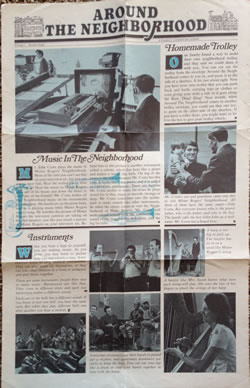
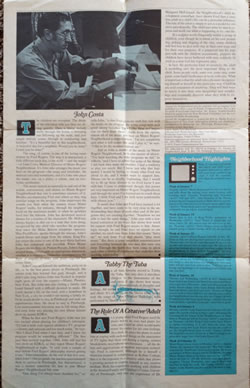
[click images for larger view]
Articles included:
- Music in the Neighborhood
- Homemade Trolley
- Instruments
- John Costa
- Tubby the Tuba
- The Role of a Creative Adult
- Neighborhood Highlights
Articles
Mr. John Costa plays the music in Mister Rogers' Neighborhood. Most of the time you can't see him on your television set, but you can always hear him. Hear the trolley give a little ding-a-ling? Hear the music as Mister Rogers goes out of his house and down the street to visit one of his friends? Mr. Costa makes all that Neighborhood music on the instruments pictured here. His hands are on the piano keys, and he is playing music while Mister Rogers sings a song. He watches the picture of Mister Rogers the television cameras are taking on his own monitor, just like you watch a picture of Mister Rogers on your television set. Behind him in this picture is another instrument called a celeste, which has keys like a piano and makes a sound like bells. On top of the piano is the new instrument Mr. Costa has this year. It looks like a toy piano, and it is called an electric synthesizer. There are buttons Mr. Costa pushes to make the notes he plays sound fat or thin, tingly or smooth, twangy or deep. Mr. Costa sometimes uses the synthesizer to make sounds like other instruments. So when the circus comes to visit the Neighborhood of Make-Believe, Mr. Costa will make circus sounds with the synthesizer: the sound of the trumpet, the trombone, and the big fat tuba.
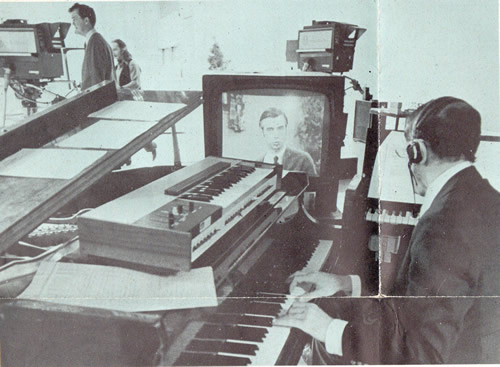
Mr. Costa's son and grandson came one day to visit Mister Rogers' Neighborhood. All three of them have the same name -- John Costa. But everyone knows who is the grandfather, who is the father, and who is the boy. The family calls the boy John-John as a nick-name. Mr. Costa has a beard here.
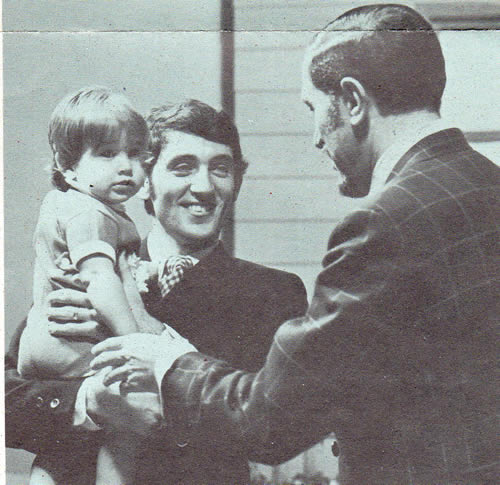
One family found a way to make their own neighborhood trolley, and they said we could share it with you. You can cut out the trolley from the envelope Around the Neighborhood comes to you in, and paste it to the side of a shoebox. If fits just about right. Now you have your own trolley that you can push back and forth, carrying toys or clothes or even giving your dolls a ride as it goes along the floor. Ding! Ding! Next month, when Around the Neighborhood comes in another trolley envelope, you could use that one too, to paste on the other side of the shoebox. If you have a roller skate, you might want to tie it to the box to give your trolley wheels.
When you hum a tune to yourself, you are making music. As you grow, you may learn to pucker your lips and whistle a tune. Some children learn to play musical instruments. They can play music by themselves, or they can join other children in a band or orchestra and play music together.
There are some instruments people blow into to make music. Harmonicas are like that. They come in different sizes, and each size harmonica makes a different sound.
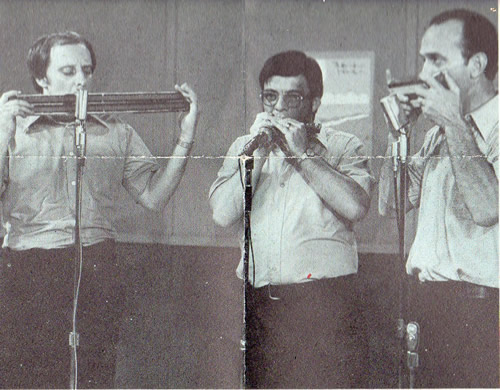
Each one of the bells has a different sound. If you listen to just one bell, you hear the same note. But when they play different bells one after another you hear a melody.
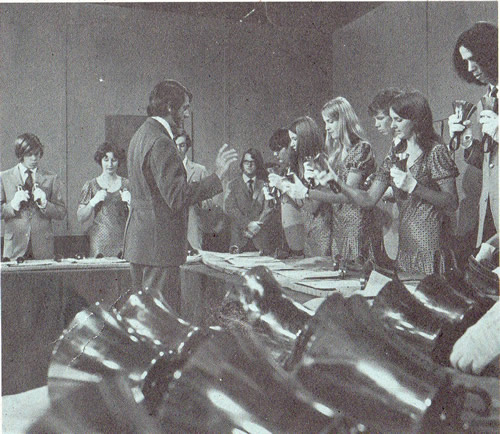
Sometimes drummers use their hands to pound out a rhythm, and sometimes drummers use sticks to keep the beat. You can use your lap like a drum or clap your hands together in time with the music.
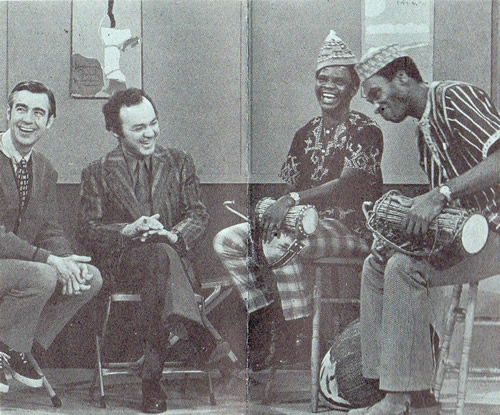
A harp is too big to pick up. The harpist has to sit on a stool like Mister Rogers is doing.
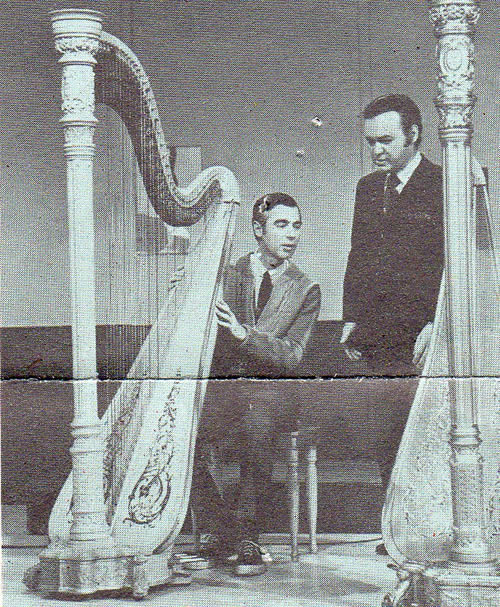
A harpist like Mrs. Susen learns what note each string will play. She uses the tips of her fingers to pluck the strings of her harp.
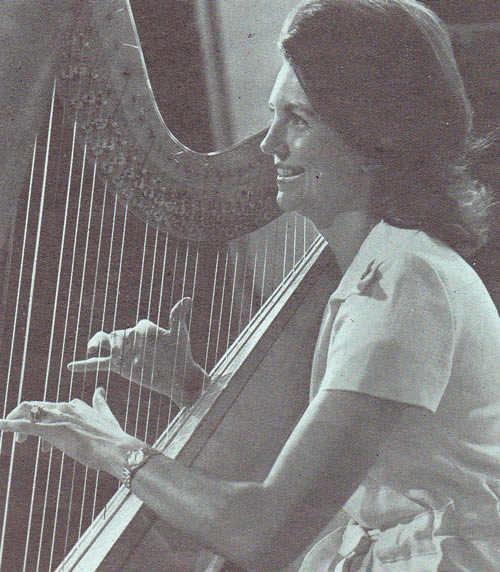
The children are occupied. The drone of the television tells you they are sitting quietly. Then a lilting melody wafts through the house, a sweeping run billowing up the scale, and that simple melody comes through so comforting and familiar: "It's a beautiful day in this neighborhood, A beautiful day for a neighbor, Would you be mind? Could you be mine?"
The song, of course, is one of the loving tunes written by Fred Rogers. The way it is interpreted, a little different each day, is the work -- and the magic -- of John Costa, Musical Director of Mister Rogers' Neighborhood. It's John who arranges the music you hear on the program -- the songs and interludes, the musical cues and transitions; and it's John who plays the music, too, on a piano, a celeste, and an electronic synthesizer.
The music weaves so naturally in and out of the action, conversation, and silence on Mister Rogers' Neighborhood that one is sometimes unaware of it. Besides accompanying Fred and others as they sing familiar songs on the program, John improvises the sounds you hear when the camera trances Mister Rogers' walks, for instance, through his neighborhood on the miniature model, or when he sprinkles food into the fishtank. John has developed musical themes for a number of characters. Mr. McFeely always bustles in and out to a tune that trots along, recognized by any child who watches the program. And when the Make-Believe telephone operator, Miss Paulificate, speaks through the telecan, John's sounds flutter and jingle from the celeste. King Friday enters the scene to one of the over thirty fanfares John has composed and recorded. When Mister Rogers shows films on Picture-Picture, John's background music always adds an appropriate dimension, whether it is expansive rhapsodies accompanying the flight or seagulls or rinky dink piano rags for fast funny films.
John Costa set himself the ambition, early on in life, to be the best piano player in Pittsburgh. His talents took him beyond that goal, though, and it didn't take long before John was booked in popular night spots all over the country -- Miami, Phoenix, New York. But John was also raising a family, and found himself with a difficult decision to make. He could choose a life on the road, with a homebase in New York, a city he couldn't see raising a family in. Or he could decide to stay in Pittsburgh and seek out opportunities there. He chose to stay in Pittsburgh. Live entertainment television was in full swing then, and soon John was playing his own fifteen minute show on station KDKA.
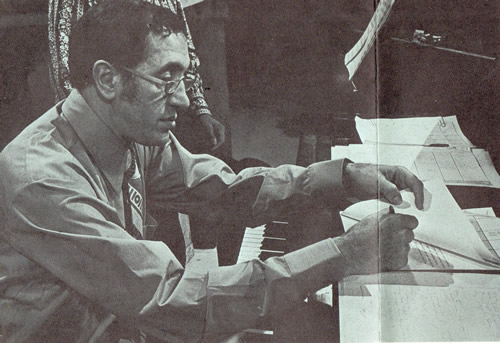
When he first met Fred Rogers, John was not too excited about playing for children's television. "I'd had it with your typical children's TV program -- clowns and cartoons and too much noise," he says. "But I liked Fred when I met him, and I knew his program would be something different." The first year they worked together, 1966, John still had his own show on KDKA, so they taped Mister Rogers' Neighborhood at night. "It only took a couple of days before Fred Rogers' philosophy started getting to me," John remembers. At the end of that first year, when John's own program, the last live entertainment show to survive Pittsburgh, was discontinued, it was a natural transition for him to join Mister Rogers' Neighborhood full time.
"One thing I've always been thankful for," recalls John, "is that Fred gives me such free rein with the music on the program. He writes songs with such good, strong melodies. Then I take them and improvise on them from there." Aside from the operas, almost all of the music you hear on Mister Rogers' Neighborhood is improvisation. "I'm not completely sure what it will sound like until I play it," he says. "I like to let the moment capture me."
Just as John is master of the music on Mister Roger's Neighborhood, he is also master of silence. "I've been watching the older programs we did," he reflects, "and I have to admit that some of the things I did back then make me shudder. I had a tendency to play too much. But I know just why that happened. I would be feeling so closely what Fred was about to do, and I would want to support him. Silence can be so deadly, frightening, that I would try to fill up those silences to let Fred know I was with him. I came to understand, though, that pauses are very important on Mister Rogers' Neighborhood, and through the years I've learned not to touch those keys. I think Fred and I are both more comfortable with silence now."
It seems that John and Fred have learned a lot together, and have come to be very close in the understanding they share of each other and of the programs they are creating together. "Somehow we are able to feel the same things," John says with a low-keyed conviction in his voice that shows how much his rapport with Fred Rogers means to him. Amazingly enough, he and Fred have no signals to one another, no catch tune from John that means "hurry up," no nod from Fred that means "play more music." But there is some unspoken communication and friendship between the two men that runs very deep. Through the years they have come to allow each other a liberty of expression that underlies their working relationship.
An all time favorite record is Tubby the Tuba. Not only does it introduce children to the instruments of the orchestra, it also shows how music can express all kinds of thoughts and feelings. All within a story full of fantasy and tears and cheer. It's available on the Decca label, along with the songs of Hans Christian Andersen, both performed by Danny Kaye.
As a young child Fred Rogers used the piano before he ever had piano lessons, and found he often would make music his outlet for his own feelings. As a man, he plays the piano to assist him in coping with such real things as the annoyance of TV lights that blow out during a taping, camera breakdowns, microphone interferences...all the delays and aggravations of modern television technology. Fred is convinced, although he is himself a musician trained in composition at Rollins College, that it is the exposure to a creative adult that allows a growing person to express himself in a creative medium. Both his experience working with children at the Arsenal Family and Children's Center, University of Pittsburgh, and also the experience of Dr. Margaret McFarland, the Neighborhood's child development consultant, have shown Fred that a creative adult in a child's life can be a powerful influence. The role of the adult is simply to act as a model for creative uses of media. The child uses what he sees to express and work out what is happening in his own life.
If a sculptor works frequently within a group of children, even though he is intent on his own pounding, poking and shaping of the clay, many children will feel free to deal with clay in their own ways and for their own purposes. If a puppeteer lets his puppets talk with the children occasionally, puppets the children have never bothered with may suddenly be used as a new tool for expressive play.
In fact, the particular kind of creativity the adult is modeling isn't the most important thing to the child. Some people cook, some sew, some sing, some paint, some build birdhouses or work with cars. What is important is that the adult takes pleasure in expressing himself or herself in this particular way. Children are avid consumers of creativity. They will find ways to weave it into their own imaginings and wonderings and eventually discover what they wish to express themselves.
Note: if you miss a program that you or your child is particularly interested in, check with your local station to see when it will be repeated. Give them the program number.
Week of January 7
Tuesday (#427) Mister Rogers goes to visit the dentist and talks about the waiting room, teeth-cleaning, and brushing teeth. Tuesday, Wednesday, and Thursday (#427, 428 and 429) John Reardon of the Metropolitan Opera Company comes to Make Believe and begins to work with everyone on the new opera, and Friday (#430), "Potato Bugs and Cows," an opera about a discontented cow on a farm, is performed.
Week of January 14
Queen Sara is sick, as King Friday announces on Wednesday (#433). Since Daniel is afraid she will never return, Dr. Bill assures him she will soon be better. Thursday (#434) Mister Rogers shows a film of himself going to Esther Farnas, M.D. for an injection.
Week of January 21
Tuesday (#437) Mister Rogers visits Mr. & Mrs. McFeely as they are packing their suitcase to go on a trip. The next day (#438) he visits Marianne Wion, a woman who uses electric saws to make toys. He talks to her about her feelings about being a working mother. In the Neighborhood of Make-Believe Wednesday, the king and queen have a disagreement, and the others are worried about their anger. Lady Aberlin spends Thursday (#439) asking the Neighbors of Make-Believe what love really is, and she learns that people who love each other still get mad from time to time. That's all part of loving; caring enough to do something helpful about any way you feel.
Week of January 28
Tuesday and Wednesday (#442 & 443) Handyman Negri helps Lady Elaine and Henrietta understand themselves and their differences -- Henrietta likes to keep her pretty dresses clean, while Lady Elaine likes to work hard and doesn't care if she gets dirty. Handyman Negri assures both of them that they are equally important to the Neighborhood just the way they are. Friday (#445) Corney learns that many good things -- whether they are work projects, vegetables, or people -- need time to grow.
Week of February 4
Monday (#446) Lady Elaine decides that she will wallpaper the outside of King Friday's castle and magically rearrange all the houses in the Neighborhood of Make-Believe. People get lost on Tuesday (#447) and finally on Thursday (#448) King Friday orders Lady Elaine to replace everything. It is only when she hears Ana Platypus crying that Lady Elaine decides she ought to put the Neighborhood back in order. Friday (#450) the Neighbors declare a Festival of Mad Feelings to express their anger over what Lady Elaine did.
Week of February 11
Mister Rogers has a visitor on Monday (#451). Morrie Turner, the cartoonist who draws the "Wee Pals" comic strip and the "Kid Power" television program. He draws caricatures of Mister Rogers and his Neighbors. Tuesday Mister Rogers shows a leg brace and crutches (#452) before he goes to visit the McFeelys and their granddaughter, Chrissy Thompson, who uses a brace and crutches to help her walk. On Friday (#455) Lady Elaine, Lady Aberlin, and Harriett E. Cow forma singing trio.
Credits
Around the Neighborhood and the materials that accompany it are published ten times a year by Family Communications Inc., a not-for-profit Pennsylvania corporation. Mr. Rogers' Neighborhood is funded by grants from the Sears Foundation and the Corporation for Public Broadcasting.
Around the Neighborhood is created for FCI by Media Projects Incorporated of New York. Subscription printing and distribution accomplished by Multiscope, Inc., Pittsburgh, Pennsylvania.
Executive Editor: Sara Stein
Editor: Susan Tyler Hitchcock
Editorial Staff: Hedda Sharapan, Mary Gale Moyes
Production Supervisor: Jim Macandell
Graphic Designer: Tobias O'Mara
© 1973, Family Communications Inc.
